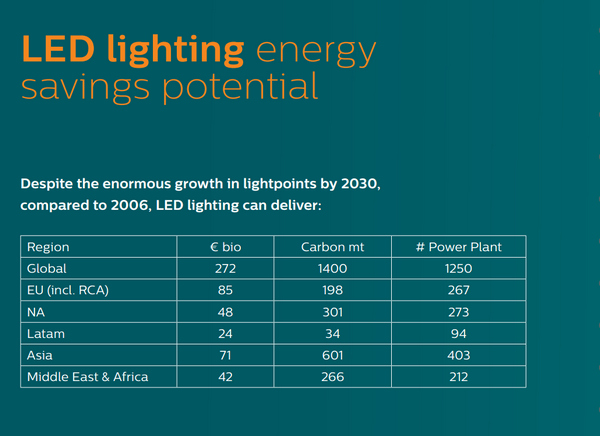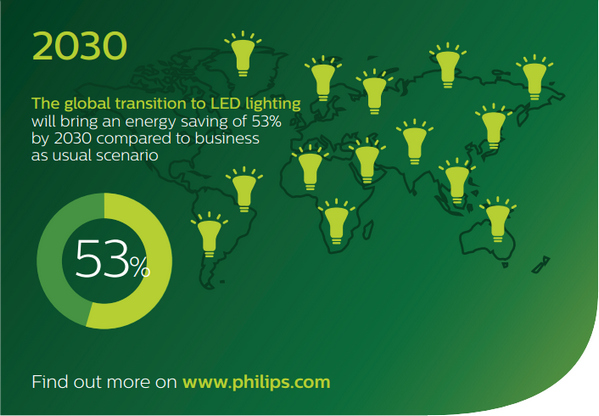At COP21 in Paris today, Philips Lighting released a paper highlighting the unprecedented energy savings potential of a global transition to light-emitting diode (LED) lighting.
Entitled ‘LED Revolution Booklet’, the research reveals that a switch of all lighting sources to LEDs could provide a global reduction in carbon emission of 1,400 Megatons by 2030 and result in economic savings of EUR 272 billion (US $295.16 billion).
 |
|
A city lit up with LEDs. (All photos courtesy of Philips) |
Lighting is responsible for 19% of global electricity consumption and accounts for nearly 6% of global CO2 emissions. So the wide-scale rollout of energy efficient lighting solutions such as LEDs would make a significant dent in carbon emissions globally.
But this scale-up needs to happen soon, because as estimated by Philips, driven by growing populations, urbanization and increasing standards of living, there will be 35% more light sources in 2030 compared to 2006 – the year when Philips called for a global phase-out of inefficient incandescent light bulbs. Since then the lighting sector has made great steps in reducing its carbon footprint, serving as an example for other sectors to follow.
 |
|
Philips calculations of estimated carbon emissions reduced and saved. |
The Climate Group has long promoted LED street lighting as one of the quickest and most effective solutions to reduce carbon emissions and save money for cities and municipalities around the world. Philips estimates that switching all such outdoor lighting in particular to LEDs could stop 109 million tons of CO2 entering the atmosphere and save EUR21 billion globally by 2030.
But to enable such a transition, it is important for governments to promote policies and legislation that sets minimum energy and quality requirements to phase out inefficient lighting technologies and work to promote financing mechanisms that help release public-private funding for such projects.
It is also vital to communicate the benefits that high-quality lighting can provide beyond just energy savings. Modern lighting solutions, such as LEDs, can help create more attractive and liveable cities, and safer roads and streets at night. Local communities also benefit from enhanced lighting of public spaces, an increased sense of safety and security as well as the potential for attracting local investment, increased tourism and stronger night-time economy.
 |
|
LEDs light up a bridge. |
Accelerating renovation of the existing infrastructure and leapfrogging to efficient and connected LED lighting solutions is also key. "The move to new LED and connected LED street lighting is encouraging," said Harry Verhaar, Head of Global Public and Government Affairs at Philips Lighting. "However the current renovation rates of existing street lighting are too slow. We need to double the renovation rate so that we keep pace with rising demand for energy. Renewing existing infrastructure with LEDs needs to be a priority if cities are to realize the benefits of saving in money and energy and better lit, safer streets."
Over the past 2 years, The Climate Group has worked in partnership with Philips Lighting and Prince Albert II of Monaco Foundation to run a global consultation with cities and municipalities to identify and address the remaining barriers to scale-up of LED street lighting. Our initial findings were presented in ‘The Big Switch’ report, and at Climate Week NYC we called for every city and utility around the world to seek to switch to LED lights (or as energy efficient) by 2025and launched our ‘LED=Lower Emissions Delivered’ campaign to focus on direct actions and interventions to support cities to achieve the 2025 LED adoption target.
Ben Ferrari, Director of Partnerships at The Climate Group comments on the release of the LED revolution booklet: "The LED Revolution Booklet is a great source of information confirming the incredible economic and environmental potential of a transition to energy efficient LED lighting globally."
This is part of the campaign LED=Lower Emissions Delivered
 |
|
Philips projects LED bulbs will reduce energy consumption by 53% worldwide by 2030. |















